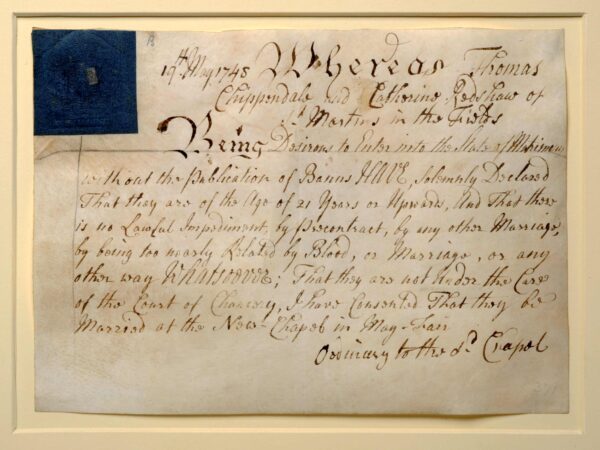
At the Chippendale Society Collection study day in August 2022 there was some discussion about the irregular character of Thomas Chippendale’s marriage license, which the Society owns (1).
One of our members, Peter White, subsequently got in touch:
‘Following on from the brief discussion about Thomas Snr’s marriage license, I did a bit of research, as the handwritten license did not look like the normal pre-printed ones in use at the time. It turns out Thomas’s marriage was a clandestine marriage… Such clandestine marriages could be done without an official licence or reading of banns. They were frowned upon and made illegal in 1754 by the Hardwicke marriage act.’
Clandestine marriages were performed by a Church of England parson but without banns or official license from the parish. They were held at several ‘lawless’ churches in London, of which the New Chapel where Chippendale was married was one. The Chapel had been established in May 1744; previously, clandestine marriages had been performed at St George’s Chapel, Mayfair, but the excommunication and imprisonment of the Reverend Alexander Keith in April 1743 for officiating at clandestine marriages caused its closure. Keith was by all accounts a colourful character (2). The New Chapel was opened in a private house near Hyde Park Corner and marriages were conducted there by Keith’s supporters from May 1744 onwards. The chapel was usually referred to as the ‘New Chapel’ or ‘Mr Keith’s Little Chapel’, and it conducted marriages for a fee of one guinea. In 1753 clandestine marriages were outlawed by Lord Hardwicke’s Marriage Act (26 Geo. II c.33), which enacted that marriages performed without banns or licence were void.
One of the most common reasons for a clandestine marriage was when one or both partners were under 21 years of age, although the handwritten license invariably included a declaration that both parties were over 21. In Chippendale’s case it is likely that his bride, Catherine Redshaw, was underage; Thomas himself was almost 30. But why the rush? The usual reason, pre-marital pregnancy, did not apply because the couple’s first child, Thomas junior, was born a respectable eleven months later. Perhaps Catherine’s parents refused consent to the marriage?
Chippendale’s second marriage to Elizabeth Davis took place on 17th July 1777, and on that occasion due process was followed. Both the marriage bond (for £200) and the marriage allegation survive in London Metropolitan Archives (3).
Article written by Adam Bowett, with many thanks to Peter White.
(1) https://search.lma.gov.uk/scripts/mwimain.dll/144/LMA_OPAC/WEB_DETAIL/REFD%20%22ACC~2F1080%22 SESSIONSEARCH&URLMARKER=STARTREQUEST
(2) Dictionary of National Biography, 1885-1900/Keith, Alexander (d.1758) – Wikisource, the free online library
(3) London Metropolitan Archives, MSS 10091E/90 & 10091/137
